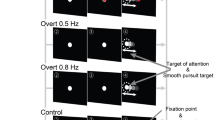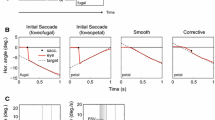Abstract
We examined the temporal and spatial properties of the effects of target saliency on the initiation of smooth pursuit eye movement in humans. Visual stimuli consisted of random dots projected on a large-field screen. During a fixation period, a cluster of dots (2×2 deg) was blinked (turned off for a short period) to make that region stand out from the remaining background and serve as a cue. After a delay (cue lead time), a cluster of dots (2×2 deg) started to move as a pursuit target. The target and cue were presented at either identical or different locations so that the subject could not predict the target location from the cue location. We examined the time course of the effect of the cue on pursuit initiation by changing the cue lead time. In half of the trials, the cue and target locations were identical, and in the other trials, they were not identical. There was a clear effect of the cue only for the trials where the cue and target locations were identical. The effect of the cue increased as cue lead time increased, peaked at ~160 ms, and then decreased. We also examined the spatial extent of the effect of the cue by varying the distance between the target and the cue. The largest effect was observed when the cue and the target were presented at the same location. Facilitating effects were observed when the target and the cue were presented in the same hemifield but not when presented in the opposite hemifield.




Similar content being viewed by others
References
Collewijn H, Van der Mark F, Jansen TC (1975) Precise recording of human eye movements. Vision Res 15:447–450
Desimone R, Ungerleider LG (1986) Multiple visual areas in the caudal superior temporal sulcus of the macaque. J Comp Neurol 248:164–189
Dursteler MR, Wurtz RH (1988) Pursuit and optokinetic deficits following chemical lesions of cortical areas MT and MST. J Neurophysiol 60:940–965
Dursteler MR, Wurtz RH, Newsome WT (1987) Directional pursuit deficits following lesions of the foveal representation within the superior temporal sulcus of the macaque monkey. J Neurophysiol 57:1262–1287
Ferrera VP, Lisberger SG (1997) Neuronal responses in visual areas MT and MST during smooth pursuit target selection. J Neurophysiol 78:1433–1446
Fuchs AF, Robinson DA (1966) A method for measuring horizontal and vertical eye movement chronically in the monkey. J Appl Physiol 21:1068–1070
Gattass R, Gross CG (1981) Visual topography of striate projection zone (MT) in posterior superior temporal sulcus of the macaque. J Neurophysiol 46:621–638
Hashimoto K, Suehiro K, Kodaka Y, Miura K, Kawano K (2003) Effect of target saliency on human smooth pursuit initiation: interocular transfer. Neurosci Res 45:211–217
Hays AV, Richmond BJ, Optican LM (1982) A UNIX-based multiple process system for real-time data acquisition and control. In, vol 2, WESCON, pp 1–10.
Hikosaka O, Miyauchi S, Shimojo S (1996) Orienting a spatial attention--its reflexive, compensatory, and voluntary mechanisms. Brain Res Cogn Brain Res 5:1-9
Ilg UJ (1997) Slow eye movements. Prog Neurobiol 53: 293–329
Kawano K, Shidara M, Watanabe Y, Yamane S (1994) Neural activity in cortical area MST of alert monkey during ocular following responses. J Neurophysiol 71:2305–2324
Komatsu H, Wurtz RH (1988) Relation of cortical areas MT and MST to pursuit eye movements. I. Localization and visual properties of neurons. J Neurophysiol 60:580–603
Komatsu H, Wurtz RH (1989) Modulation of pursuit eye movements by stimulation of cortical areas MT and MST. J Neurophysiol 62:31–47
Lisberger SG, Morris EJ, Tychsen L (1987) Visual motion processing and sensory-motor integration for smooth pursuit eye movements. Annu Rev Neurosci 10:97–129
Miura K, Suehiro K, Yamamoto M, Kodaka Y, Kawano K (2001) Initiation of smooth pursuit in humans. Dependence on target saliency. Exp Brain Res 141:242–249
Nakayama K, Mackeben M (1989) Sustained and transient components of focal visual attention. Vision Res 29:1631–1647
Recanzone GH, Wurtz RH (2000) Effects of attention on MT and MST neuronal activity during pursuit initiation. J Neurophysiol 83:777–790
Tanaka M, Lisberger SG (2000) Context-dependent smooth eye movements evoked by stationary visual stimuli in trained monkeys. J Neurophysiol 84:1748–1762
Acknowledgements.
We thank T. Furihata for secretarial assistance. This work was performed through the Advanced and Innovational Research program in Life Sciences from the Ministry of Education, Culture, Sports, Science and Technology, the Japanese Government.
Author information
Authors and Affiliations
Corresponding author
Rights and permissions
About this article
Cite this article
Hashimoto, K., Suehiro, K. & Kawano, K. Temporospatial properties of the effects of bottom-up attention on smooth pursuit initiation in humans. Exp Brain Res 156, 88–93 (2004). https://doi.org/10.1007/s00221-003-1758-0
Received:
Accepted:
Published:
Issue Date:
DOI: https://doi.org/10.1007/s00221-003-1758-0




